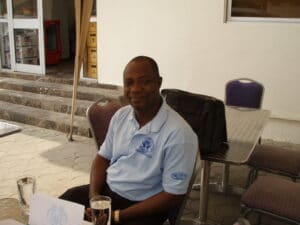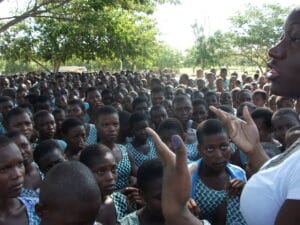Emmanuel Darko – An Agent of Change
CDF Canada is grateful to collaborate with people like Emmanuel Darko who are helping to innovate and transform old models of business, into newer, more prosperous ones. Emmanuel has vast experience with the credit union sector. As a former manager with the Ghana Co-operative Credit Union Association (CUA), and having worked with CDF Canada in various capacities since 1991, his expertise and successful track record made him an invaluable member of the team. Mr. Darko harnessed his prior experience leading a three-person team responsible for Ugandan’s revitalization and his learned knowledge over the past two decades, to rejuvenate the Ghanaian credit union system.
By taking a cooperative approach, we are pleased to say the CUA has grown from 146 credit unions to 240 in only six years, while also increasing member savings to $25 million from $4.2 million to $25 million. Thanks in big part to the passion and dedication of Emmanuel Darko.
The Fall and Rise of the CUA

Emmanuel Darko
In 1983 the Konard Adeneaur Foundation stopped its funding to the Credit Union of Africa (CUA). This resulted in the fall of the coop movement, with only 146 credit unions surviving, from its original count of 540. There was high-loan delinquency, inadequate capital, liquidity issues, and much more. Fortunately, in 1994, the World Council of Credit Unions and ACCOSCA introduced the African Revitalization Programme at a meeting in Kigali, Rwanda, which later released a study indicating that despite the setbacks, there was enormous potential for credit union development in Ghana.
The report caught the attention of the Canadian International Development Agency (CIDA) and the Canadian Co-operative Association (CCA). They recognized the challenges facing the credit union system in Ghana, but also the huge potential that existed for development, spawning an ambitious project. In true cooperative spirit, many agencies came together to collaborate on what would become a six-year project to transform the defunct credit union system in Ghana to a thriving one. The CCA and CUA, along with CIDA, the Department of Cooperatives (DOC), Bank of Ghana (BOG), and the Ministry of Employment and Social Welfare worked together to significantly increase the capacity and effectiveness of the Ghanaian credit union system, which was coined the Ghana Credit Union Development Assistance Program (GCUDAP).
The primary goals of the project were to increase:
Overcoming Obstacles
The challenges were significant. Many of the Ghanaian credit unions faced high loan delinquency, liquidity issues, and problems with accounting and governance. Furthermore, at the national level, the image of the cooperative movement and CUA itself was unpopular. The CUA and CCA worked tirelessly to achieve their goals and overcome barriers, through extensive training programs for staff, management, and board members; development of new policies, plans, and programs; alongside numerous organizational restructurings, promotions, and new positions.
 The key to the new direction for CUA was the adoption and promotion of the ‘New Model’ of Credit Union Development, as guided by the consensus reached by ACCOSCA. The traditional ‘old model’ of credit unions in the country was closer to a social organization, usually volunteer-operated and operating out of whatever space was available. In contrast, the new model sought to make credit unions more professional and business-minded. Under this new model, CUs would be required to operate on professional management principles, adopt modern accounting practices, have at least some paid staff, and establish a proper office space. What remained steadfast throughout this evolution, was the commitment to the cooperative principles. A strategic balance of core credit union values and modern business principles and practices was necessary for the institutions to become more competitive and sustainable; ultimately better serving the needs of more members through the new approach.
The key to the new direction for CUA was the adoption and promotion of the ‘New Model’ of Credit Union Development, as guided by the consensus reached by ACCOSCA. The traditional ‘old model’ of credit unions in the country was closer to a social organization, usually volunteer-operated and operating out of whatever space was available. In contrast, the new model sought to make credit unions more professional and business-minded. Under this new model, CUs would be required to operate on professional management principles, adopt modern accounting practices, have at least some paid staff, and establish a proper office space. What remained steadfast throughout this evolution, was the commitment to the cooperative principles. A strategic balance of core credit union values and modern business principles and practices was necessary for the institutions to become more competitive and sustainable; ultimately better serving the needs of more members through the new approach.
Prepared for Change
The CDF representatives were well-equipped to guide the transition on the ground. They received a comprehensive briefing on the new model before their arrival and were very open and willing to share their lived experiences. They adapted well to local conditions and were prepared to immerse themselves in Ghanaian culture, food, and the conditions of rural living. Adapting so well to local conditions and culture was of huge benefit when it came to information dissemination and knowledge transfer to the local people, who viewed the CDF team as being very respectful of their ways. Of course, Emmanuel Darko and Bob Bildfell were onsite to provide necessary guidance and support to the entire CDF team, ensuring a smooth transition.
Immense Impact
Support was received from a diverse team of Canadian professionals with expertise in legislation, deposit guarantee schemes, lobbying, governance, and project management. In total, over 30 interns and 120+ coaches shared their experiences with the credit unions in Ghana, in support of the transition to the new credit union model. Additionally, over 40 women participated in the Women’s Mentorship Program, enabling them to positively impact their leadership and operations back home.
Opportunities to participate in the CDF Congress were also provided to some of the Ghanaian credit union board and management, and even government officials, where they learned about the evolution and development of credit unions in Canada. All in all, the support, sharing, and knowledge transfer by the Canadian teams had a tremendous impact on the local Ghanaians. In fact, Ghana now has the second most successful credit union system in Africa, after Kenya.
Impact Beyond Ghana
CDF Canada has extended its support to many other African countries including: